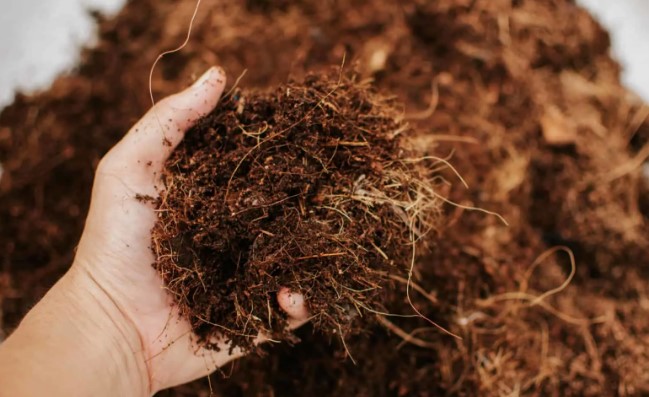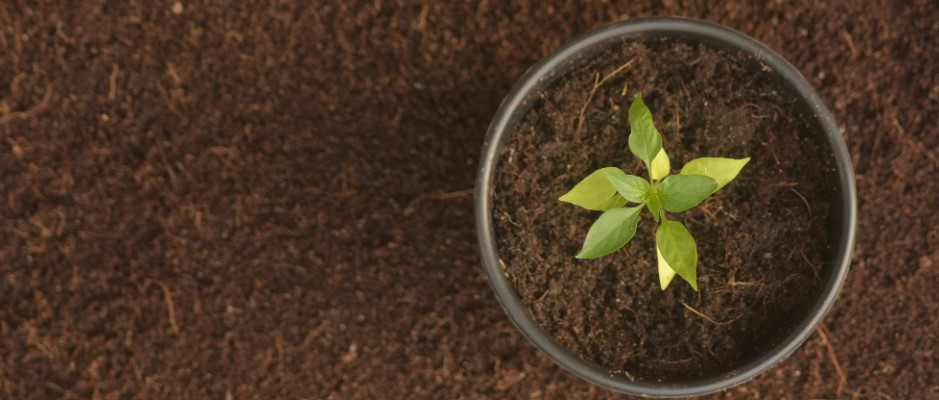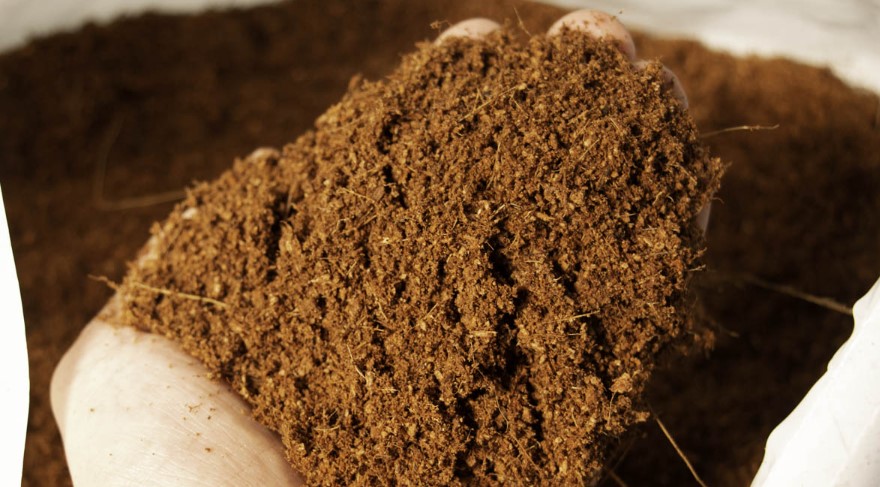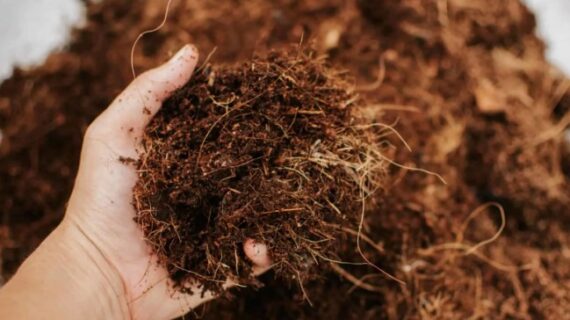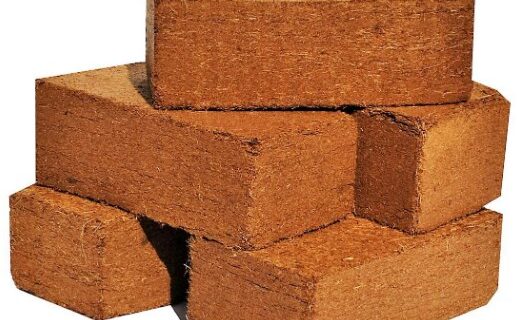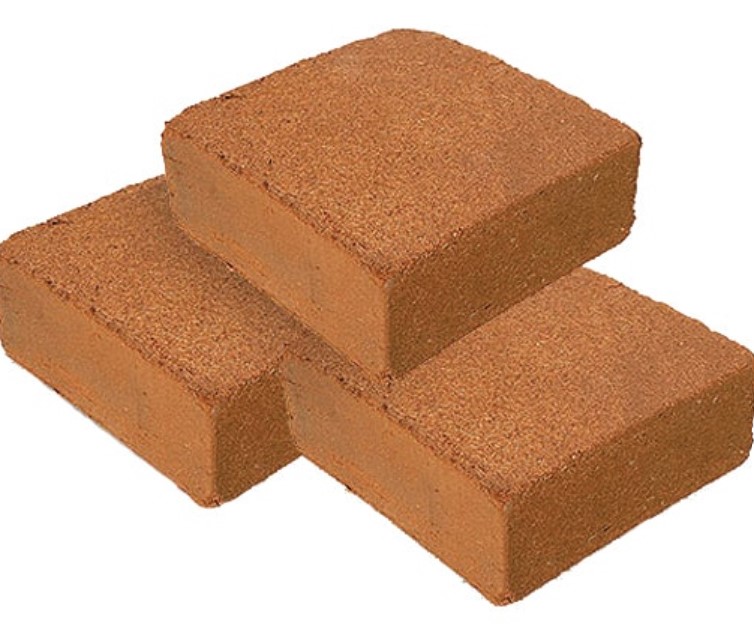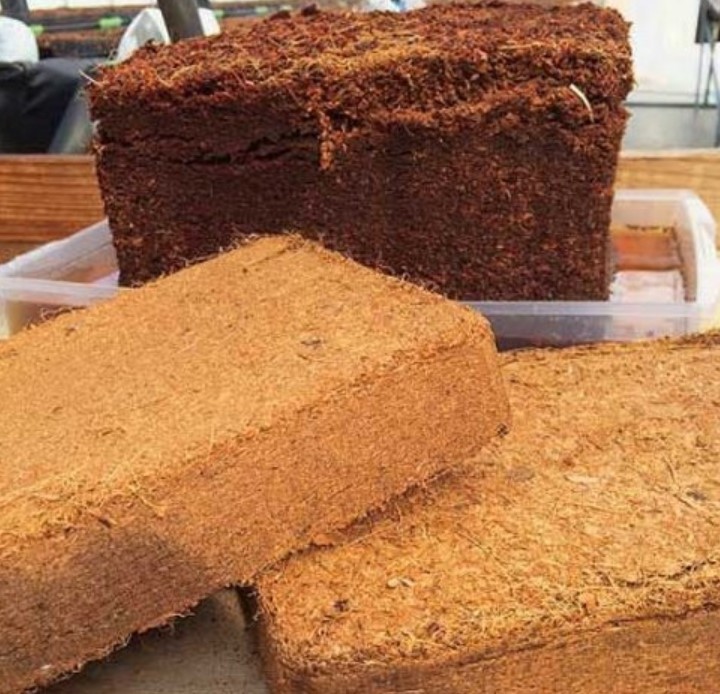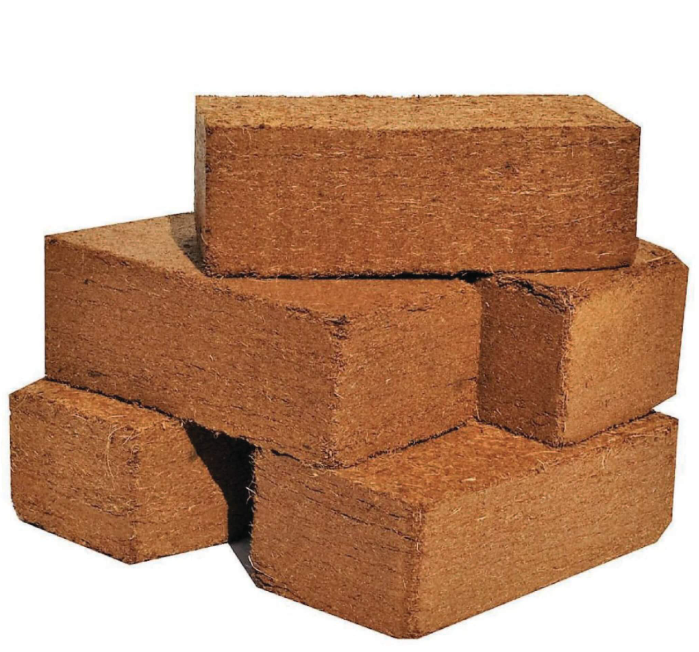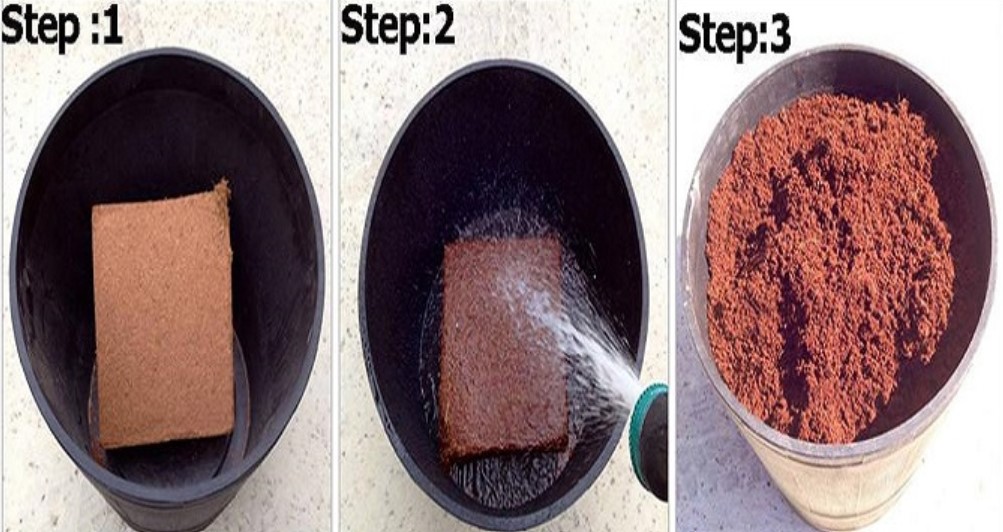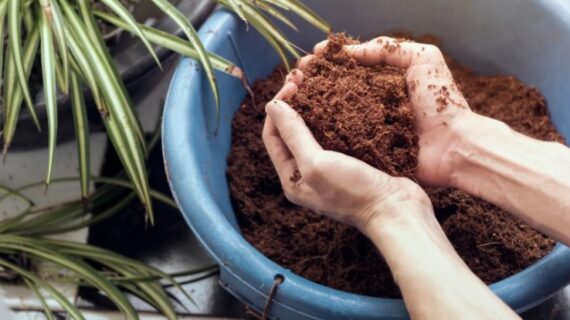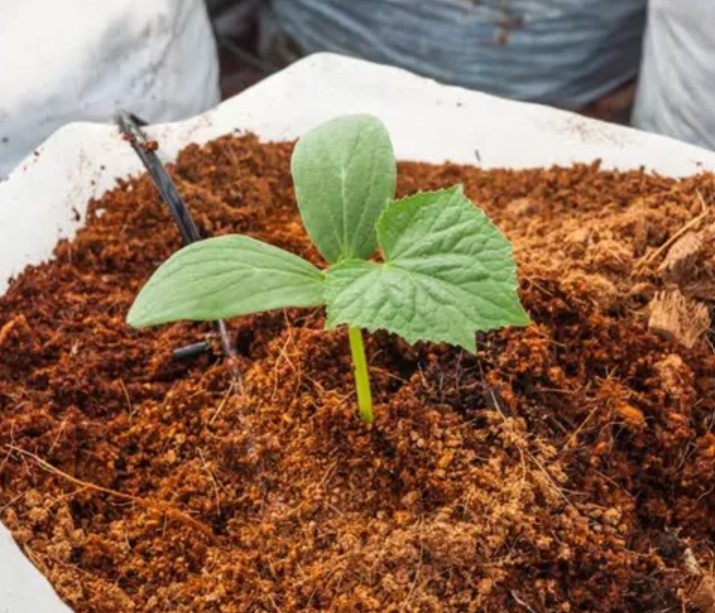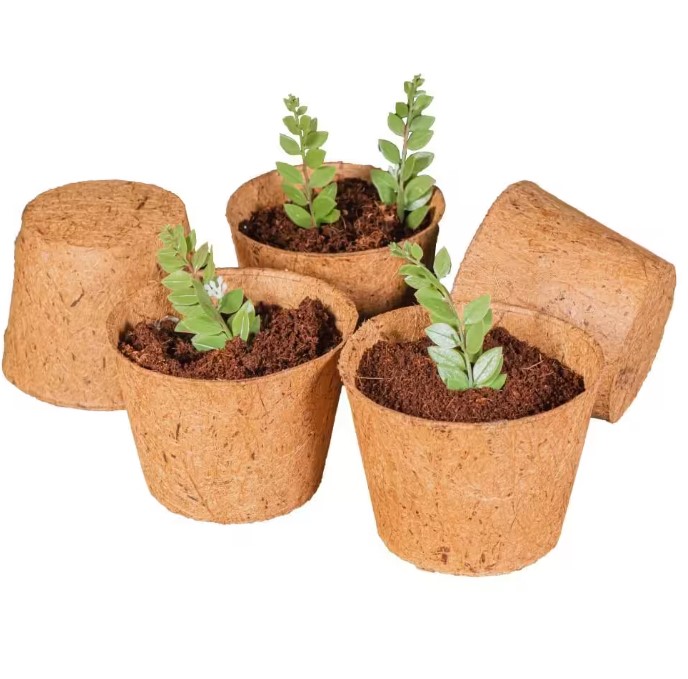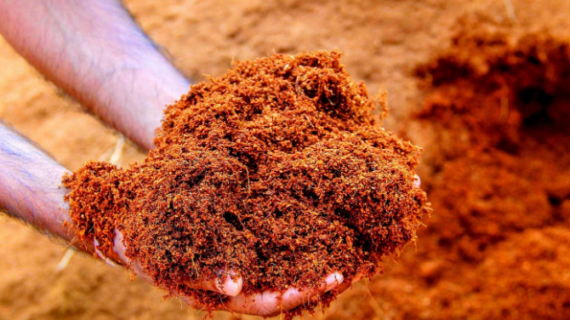Coco peat soil, also known as coir or coir dust, is a revolutionary planting medium that has gained widespread recognition for its eco-friendliness and outstanding horticultural benefits.
Extracted from coconut husks, coco peat is a renewable resource that has proven to be a game-changer in modern gardening and agricultural practices.
In this comprehensive guide, we explore the nature, uses, properties, and advantages of coco peat soil, as well as how to harness its potential for optimal plant growth.
What is Coco Peat Soil?
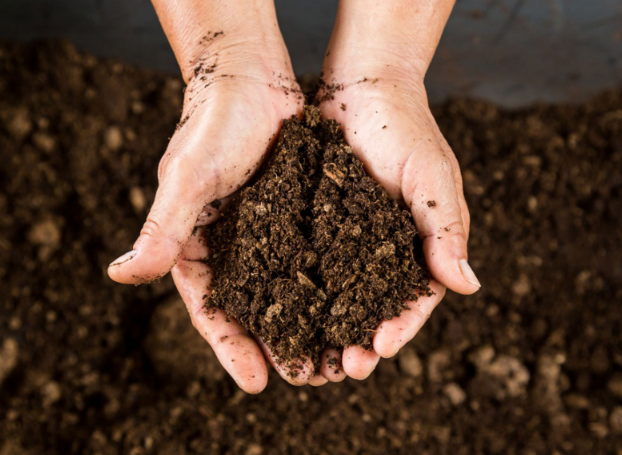
Coco peat soil, also known as coir or coir dust, is a natural and eco-friendly planting medium derived from coconut husks. It is obtained through a process that involves soaking, crushing, and drying coconut husks to remove excess moisture.
The remaining fibrous material is then sieved to create fine particles, resulting in a lightweight, highly absorbent, and nutrient-rich substrate.
Coco peat soil is a popular choice among gardeners and farmers due to its outstanding water retention properties, excellent aeration, and neutral pH level.
These characteristics make it a versatile and sustainable alternative to traditional soil mediums in various horticultural applications.
Additionally, coco peat is renewable, as it utilizes waste materials from coconut processing, contributing to greener and more environmentally conscious gardening practices.
How to use coco peat for plants?
Using coco peat for plants is relatively easy and can be done in various ways, depending on the specific needs of your plants and gardening preferences. Here is a step-by-step guide on how to use coco peat effectively:
1. Hydrate the Coco Peat:
Coco peat is often sold in a dehydrated and compressed form, so the first step is to hydrate it. Place the required amount of coco peat in a large container and add water.
Allow it to soak for a few hours or until it expands and becomes loose. Stir the mixture occasionally to ensure even hydration.
2. Prepare the Planting Container:
Choose a clean container suitable for your plant. It could be a pot, planter, grow bag, or garden bed. Ensure the container has drainage holes at the bottom to prevent waterlogging.
3. Blend Coco Peat with Other Growing Mediums (Optional):
Coco peat can be used as a standalone medium, but it is often mixed with other materials like perlite or vermiculite to enhance aeration and drainage.
For certain plants, you can also mix it with compost or organic fertilizers to provide additional nutrients.
4. Fill the Container:
Add the hydrated coco peat (or the coco peat blend) to the planting container, filling it to the desired level. Leave some space at the top to accommodate the plant and for watering.
5. Plant Your Seedling or Plant:
Gently place the seedling or plant in the center of the container, making sure the roots are spread out and not tangled. Add more coco peat around the plant to fill any gaps and provide support.
6. Water the Plant:
After planting, water the container thoroughly, allowing the coco peat to absorb and retain the moisture. Coco peat’s excellent water retention capacity will help maintain a consistent moisture level around the plant’s roots.
7. Monitor Watering:
Monitor the moisture level within the container. Coco peat retains water well, so be cautious not to overwater, as this can lead to root rot. Allow the top layer of coco peat to dry slightly before watering again.
8. Fertilize as Needed:
Coco peat itself is low in nutrients, so it’s essential to fertilize your plants regularly. Depending on the type of plants you are growing, choose a suitable fertilizer and follow the recommended application rates.
9. Maintain Proper Drainage:
To safeguard plant health, ensure the container possesses ample drainage to avoid waterlogging. Excess water should be able to flow out freely through the drainage holes.
10. Reuse and Recycle:
Coco peat is a durable medium and can be reused for multiple growing seasons. After harvesting a crop or at the end of the season, you can revitalize the coco peat by adding fresh nutrients and blending it with new materials.
Coco peat: Uses in hydroponics
Coco peat is an exceptional and widely used medium in hydroponics, a soilless cultivation technique that relies on nutrient-rich water solutions for plant growth.
Its unique properties make it an ideal choice for various hydroponic systems. Here are some of the key uses of coco peat in hydroponics:
1. Substrate in Ebb and Flow Systems:
In ebb and flow hydroponic systems, where nutrient-rich water periodically floods and drains the growing container, coco peat acts as an excellent substrate.
Its ability to retain water and nutrients while providing adequate aeration to the plant roots makes it an efficient growing medium for this setup.
2. Growing Medium in Drip Irrigation Systems:
Drip irrigation hydroponic systems deliver nutrient solutions directly to the plant roots through a network of tubes with drip emitters.
Coco peat, with its water retention capacity, helps maintain a steady water supply to the rootswhile ensuring the plant receives essential nutrients.
3. Component in Nutrient Film Technique (NFT) Systems:
NFT systems allow a thin film of nutrient solution to flow over the plant roots in a shallow channel. Coco peat can be used as a substrate in NFT systems, providing support to the plants and holding the nutrient solution, ensuring it comes into contact with the roots.
4. Buffer in Deep Water Culture (DWC) Systems:
In DWC hydroponics, plants are suspended in nutrient solutions, with their roots submerged in water. Coco peat can be used as a buffer to hold the plants securely and maintain a stable pH level in the water, preventing rapid pH fluctuations that could harm the plants.
5. Container Gardening in Hydroponics:
Coco peat can be used as a growing medium in containers for hydroponic gardening. By filling containers with hydrated coco peat, you create a suitable environment for plants to grow without traditional soil, encouraging healthy root development.
6. Seed Starting Medium:
Coco peat is a gentle and nurturing medium for starting seeds in hydroponics. Its soft texture provides a favorable environment for germination and early seedling growth, ensuring a successful start to the plant’s life cycle.
7. Organic Alternative to Rockwool or Oasis Cubes:
In hydroponics, rockwool and oasis cubes are commonly used as seedling starter plugs. However, coco peat offers a sustainable and organic alternative, providing similar moisture retention and support for young plants.
8. Reusable and Sustainable Medium:
Coco peat is a durable and reusable medium in hydroponics. After a growing cycle, it can be rinsed, sterilized, and revitalized with nutrients, making it an environmentally friendly choice for sustainable hydroponic gardening.
How to Use Coco Peat?
Using coco peat is simple and versatile, making it suitable for various gardening applications. Here’s a step-by-step guide on how to use coco peat effectively:
1. Hydrate the Coco Peat:
Coco peat is usually sold in a dehydrated and compressed form to reduce storage space. Before use, hydrate the coco peat by placing it in a large container and adding water. Allow it to soak for a few hours or until it expands and becomes loose. Stir the mixture occasionally to ensure even hydration.
2. Choose a Planting Container:
Select a clean planting container suitable for your plants. It can be a pot, planter, grow bag, raised bed, or any other appropriate container. Make sure the container is equipped with drainage holes at the base, preventing waterlogging.
3. Prepare Coco Peat Blend (Optional):
Coco peat can be used as a standalone medium, but it is often mixed with other materials to enhance its properties. For better aeration and drainage, you can blend coco peat with perlite, vermiculite, or sand. For additional nutrients, mix it with compost or organic fertilizers.
4. Fill the Container:
Add the hydrated coco peat (or the coco peat blend) to the planting container, filling it to the desired level. Leave some space at the top to accommodate the plant and for watering.
5. Plant Your Seedlings or Plants:
Gently place the seedlings or plants in the container, making sure the roots are spread out and not tangled. Add more coco peat around the plants to fill any gaps and provide support.
6. Water the Plants:
After planting, water the container thoroughly to ensure the coco peat absorbs and retains the moisture. Coco peat’s excellent water retention capacity will help maintain a consistent moisture level around the plant roots.
7. Monitor Watering:
Keep an eye on the moisture level in the container. Coco peat retains water well, so avoid overwatering, as this can lead to root rot. Allow the top layer of coco peat to dry slightly before watering again.
8. Fertilize as Needed:
Coco peat itself is low in nutrients, so regular fertilization is necessary to provide essential elements for plant growth. Depending on the type of plants you are growing, choose a suitable fertilizer and follow the recommended application rates.
9. Reuse and Recycle:
Coco peat is a durable medium and can be reused for multiple growing seasons. After harvesting a crop or at the end of the season, you can revitalize the coco peat by adding fresh nutrients and blending it with new materials.
Types of Coco Peat for Plants
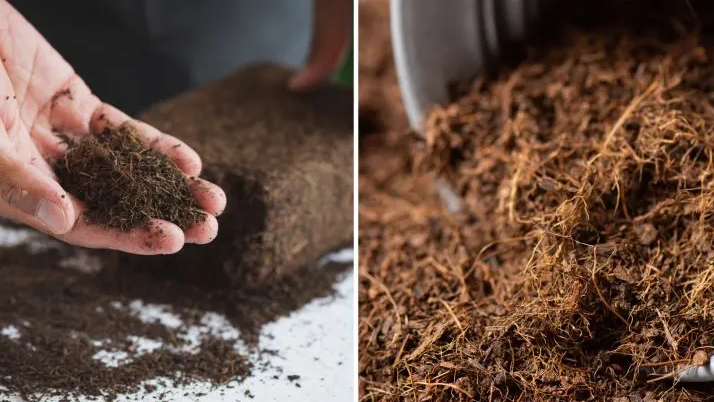
There are several types of coco peat available for plants, each with distinct characteristics and applications. The different types of coco peat are usually classified based on their processing methods and properties. Here are the main types:
1. Buffered Coco Peat:
Buffered coco peat undergoes a process where it is washed multiple times to remove excess salts and impurities. This treatment reduces the risk of high electrical conductivity (EC) levels in the medium, making it suitable for a broader range of plants.
Buffered coco peat is preferred for sensitive plants that are susceptible to salt buildup.
2. Unbuffered Coco Peat:
Unbuffered coco peat is not subjected to the same extensive washing process as buffered coco peat. It may retain higher levels of salts, which can affect some plants’ growth if not adequately flushed or leached before use.
Unbuffered coco peat is more suitable for plants that can tolerate higher EC levels or for mixing with other substrates in custom blends.
3. Washed Coco Peat:
Washed coco peat has undergone a standard washing process to remove excess salts and impurities. While not as extensively washed as buffered coco peat, it still offers a lower EC level compared to raw or unwashed coco peat.
Washed coco peat is generally suitable for most plants and is a popular choice for gardening applications.
4. Compressed Coco Peat Brick:
Compressed coco peat is sold in the form of bricks or blocks, where dehydrated coco peat is compressed into compact shapes.
When hydrated, these bricks expand to a larger volume, making them space-efficient for storage and transportation. Compressed coco peat bricks are convenient for home gardeners and small-scale plant enthusiasts.
5. Coarse Coco Peat:
Coarse coco peat refers to the larger particles of coir dust in the medium. It provides better aeration and drainage, making it suitable for plants that require excellent root oxygenation. Coarse coco peat is commonly used in hydroponic systems and for plants that prefer a well-draining substrate.
6. Fine Coco Peat:
Fine coco peat consists of smaller particles, offering higher water retention capabilities. It is well-suited for plants that require a more consistently moist environment. Fine coco peat is often used in seed starting mixes or as a component in potting mixes for moisture-loving plants.
7. Low EC Coco Peat:
Low electrical conductivity (EC) coco peat is carefully processed to ensure the medium has minimal salt content. This type of coco peat is specifically designed for sensitive plants, including some types of orchids and other acid-loving species.
Benefits of Coco Peat:
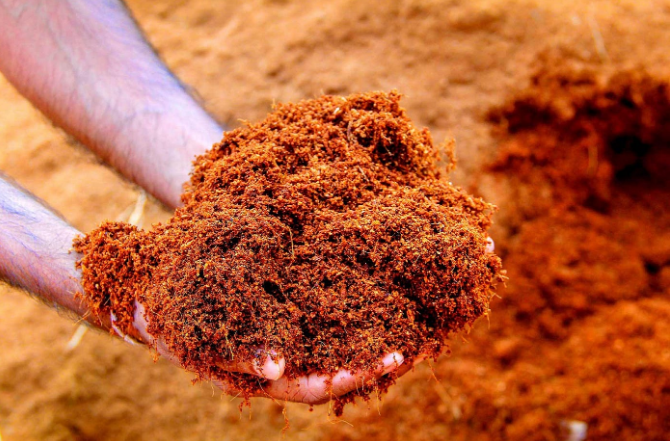
Coco peat, also known as coir or coir dust, offers numerous benefits for gardening and agricultural practices. Its unique properties make it a highly sought-after planting medium. Below are several advantages of incorporating coco peat into your gardening practices.
1. Excellent Water Retention:
Coco peat has exceptional water retention capabilities, holding up to 10 times its weight in water. This property ensures a steady supply of moisture to plant roots, reducing the frequency of watering and promoting more efficient water usage.
2. Enhanced Aeration:
The fibrous structure of coco peat allows for excellent air circulation within the root zone. This enhanced aeration promotes healthy root growth and helps prevent waterlogging and root rot.
3. Nutrient-Rich:
While coco peat itself is low in nutrients, it acts as an excellent medium for nutrient supplementation. It can be combined with organic fertilizers or nutrient solutions, allowing for better nutrient absorption by plants.
4. pH Neutral:
Coco peat has a neutral pH level, making it suitable for a wide range of plants. Its neutral nature provides a stable environment for plant roots, preventing pH-related nutrient deficiencies or toxicities.
5. Weed Suppression;
Coco peat has natural weed-suppressing properties, reducing weed germination and growth. This characteristic helps keep the garden beds or containers weed-free, minimizing competition for nutrients and resources.
6. Disease Resistance:
Coco peat exhibits innate resistance to harmful pathogens and pests. Using coco peat in gardening can contribute to healthier plants, as it reduces the risk of soil-borne diseases.
7. Sustainable and Renewable Resource:
Coco peat is derived from coconut husks, which are a renewable resource. Using coco peat promotes sustainable gardening practices by repurposing waste materials from coconut cultivation.
8. Eco-Friendly Alternative to Peat Moss:
Unlike traditional peat moss, which is harvested from ecologically sensitive peat bogs, coco peat is an eco-friendly alternative that does not contribute to habitat destruction or carbon emissions.
9. Versatility:
Coco peat is a versatile planting medium that can be used in various gardening applications, such as container gardening, raised beds, seed starting, and hydroponics.
10. Lightweight and Easy to Handle:
Coco peat is lightweight and easy to handle, making it convenient for both amateur gardeners and commercial growers. Its lightness also reduces the overall weight of large containers or pots.
11. Improved Soil Structure:
When incorporated into garden soil, coco peat improves the soil structure by increasing aeration and water retention. It also helps to loosen heavy soils and enhances their overall fertility.
12. Reusability:
Coco peat can be reused for multiple growing seasons. After a harvest, it can be rehydrated, supplemented with fresh nutrients, and used again, making it a cost-effective and sustainable choice.
How is Coco Peat Better than Traditional Peat?
Coco peat offers several advantages over traditional peat, making it a superior and more sustainable choice for gardening and agricultural practices. Here are some key reasons why coco peat is better than traditional peat:
1.Sustainability:
Coco peat is derived from the husks of coconuts, a renewable resource. Coconut palms produce fruit year-round, making coco peat a sustainable and eco-friendly alternative.
In contrast, traditional peat is harvested from sensitive peat bogs, which are slow to regenerate and contribute to habitat destruction and carbon emissions.
2. Environmental Impact:
Harvesting traditional peat releases carbon dioxide, a greenhouse gas, into the atmosphere. This contributes to climate change and negatively impacts delicate peatland ecosystems.
Using coco peat reduces the demand for traditional peat, thereby helping to preserve these valuable natural habitats.
3. Reduced Soil Degradation:
Traditional peat extraction disrupts natural peat bogs, leading to soil degradation and loss of important ecological functions. On the other hand, coco peat production repurposes waste materials from coconut cultivation, minimizing the environmental impact.
4. Water Conservation:
Coco peat’s excellent water retention properties reduce the frequency of irrigation. It holds water efficiently, allowing plants to access moisture for extended periods. This water-saving feature is particularly beneficial in regions facing water scarcity.
5. Enhanced Aeration:
Coco peat’s fibrous structure promotes better air circulation in the root zone. It prevents soil compaction and allows roots to access oxygen more effectively compared to traditional peat, leading to healthier root systems and improved plant growth.
6. Neutral Ph:
Coco peat has a neutral pH level, which provides a stable growing environment for a wide range of plants. In contrast, traditional peat may have acidic pH levels, limiting its use for certain plant species that prefer a more neutral or alkaline soil.
7. Weed and Pathogen Suppression:
Coco peat’s natural resistance to weed growth and soil-borne pathogens helps maintain a healthier garden environment. Traditional peat does not possess these inherent protective properties.
8. Versatility:
Coco peat can be used in various gardening applications, including container gardening, raised beds, seed starting, and hydroponics. Its versatility makes it suitable for a broad range of plants and cultivation methods.
9. Lightweight:
Coco peat is lightweight, making it easier to handle and transport. This feature is particularly advantageous for large-scale agriculture and gardening, reducing labor and transportation costs.
10. Reusability:
Coco peat can be reused for multiple growing seasons with proper care and maintenance. Traditional peat, once used, may not be reusable and often needs to be discarded, leading to additional waste.
Coco peat: Uses for gardening
Coco peat, also known as coir or coir dust, has a wide range of uses in gardening due to its exceptional properties and versatility. It serves as an excellent planting medium and amendment, offering various benefits for gardeners. Here are some key uses of coco peat in gardening:
1. Potting Mix:
Coco peat can be used as a standalone or blended with other materials to create potting mixes. Its water retention and aeration properties ensure optimal conditions for plant growth in containers.
2. Seed Starting:
Coco peat provides a nurturing environment for germinating seeds. Its fine texture promotes seedling emergence and early root development, making it an ideal medium for starting seeds.
3. Soil Amendment:
When incorporated into garden soil, coco peat improves soil structure and water retention. It loosens heavy soils and enhances their overall fertility, benefiting plant growth and nutrient availability.
4. Raised Beds:
Coco peat is well-suited for raised bed gardening. It can be used as a layer in raised beds to improve drainage and water retention, providing a suitable environment for plant roots.
5. Mulching:
Coco peat can be used as a mulch to cover the soil surface around plants. Mulching with coco peat helps retain soil moisture, suppress weeds, and regulate soil temperature.
6. Container Gardening:
Coco peat is popular for container gardening, where it acts as a growing medium for plants in pots, planters, and grow bags. Its lightweight nature makes it easy to handle and maneuver containers.
7. Hydroponics:
Coco peat is an excellent substrate for hydroponic systems. It provides essential support for plant roots and helps maintain an optimal water-to-air ratio in hydroponic setups.
8. Soilless Mixes:
Coco peat is an essential component in soilless mixes used in hydroponics, aquaponics, and container gardening. It is combined with other materials like perlite, vermiculite, or clay pellets to create balanced and efficient growing media.
9. Indoor Plants:
Coco peat is widely used for indoor plants, providing them with a well-draining and moisture-retentive growing medium suitable for their limited root space.
10. Green Roofs:
Coco peat is used in green roof systems to enhance soil structure, reduce weight, and support plant growth in rooftop gardens.
11. Transplanting:
Coco peat helps ease the stress of transplanting by providing a stable and nourishing environment for newly transplanted seedlings or plants.
12. Vermicomposting:
Coco peat can be used as a bedding material for vermicomposting, creating a suitable habitat for earthworms and promoting efficient composting.
What is the recommended frequency for fertilizing plants when using coco peat?
Plants grown in coco peat require regular fertilization because coco peat itself is low in nutrients. Unlike soil, which may contain some natural nutrients, coco peat is essentially an inert medium. Therefore, it’s essential to provide plants with the necessary nutrients through fertilization.
The frequency of fertilization will depend on several factors, including the type of plants being grown, the stage of growth, and the specific fertilizer used. Here are some general guidelines for fertilizing plants in coco peat:
1. Start Fertilizing Early:
Begin fertilizing the plants once they have established a good root system and are actively growing. For seedlings, this may start a few weeks after germination, and for transplants, it may begin a few weeks after they are established.
2. Follow Fertilizer Recommendations:
Always follow the manufacturer’s recommendations on the fertilizer packaging for the type of plants you are growing and the stage of growth. Different plants have different nutrient requirements, and overfertilizing can lead to nutrient imbalances or even damage to the plants.
3. Use Balanced Fertilizers:
A balanced fertilizer with an equal ratio of nitrogen (N), phosphorus (P), and potassium (K) is generally suitable for most plants. For example, a fertilizer labeled as 10-10-10 or 20-20-20 provides equal amounts of these essential nutrients.
4. Adjust Fertilization Based on Growth Stage:
Young, actively growing plants may require more frequent fertilization than mature, established plants. During periods of rapid growth, like flowering or fruiting, plants may have higher nutrient demands.
5. Consider Slow-Release Fertilizers:
Slow-release or controlled-release fertilizers can provide nutrients gradually over an extended period, reducing the need for frequent fertilization. This type of fertilizer can be convenient for busy gardeners or for plants in containers.
6. Leach Excess Salts:
Over time, fertilizer salts can accumulate in coco peat, potentially affecting plant health. To prevent salt buildup, periodically leach the coco peat by watering the plants thoroughly with plain water to flush out excess salts.
7. Monitor Plant Health:
Keep an eye on your plants’ overall health and appearance. Signs of nutrient deficiencies or excesses, such as yellowing leaves or stunted growth, may indicate a need to adjust your fertilization regimen.
8. Adjust to Environmental Factors:
Environmental factors, such as temperature, humidity, and light levels, can influence plant nutrient requirements. During periods of high environmental stress, plants may benefit from additional or modified fertilization.
Where is coco peat used?
Coco peat, also known as coir or coir dust, is used in various applications due to its exceptional properties and versatility. It finds widespread use in different industries and settings. Here are some common places where coco peat is used:
1. Gardening and Horticulture:
Coco peat is extensively used in gardening and horticulture as a planting medium and soil amendment. It is used in potting mixes, raised beds, container gardening, hydroponics, and other soilless cultivation methods.
2. Agriculture:
In traditional agriculture, coco peat is used to improve soil structure and water retention. It is often mixed with garden soil to enhance fertility and drainage.
3. Greenhouse Cultivation:
Coco peat is favored in greenhouse cultivation due to its ability to hold moisture, provide aeration, and support healthy plant growth in controlled environments.
4. Nursery Industry:
In the nursery industry, coco peat is used for seed starting, plant propagation, and growing young plants until they are ready for sale or transplanting.
5. Landscaping:
Coco peat is used in landscaping projects for soil preparation and planting in gardens, parks, and public spaces. :
6. Turf Establishment
Coco peat is sometimes used for establishing turf or grass on lawns and sports fields.
7. Erosion Control
Coco peat is used in erosion control applications to stabilize soil on slopes and prevent soil erosion.
8.Green Roof:
Coco peat is utilized in green roof systems to provide a lightweight, moisture-retentive substrate for growing plants on rooftops.
9. Vermicomposting:
Coco peat serves as a bedding material for vermicomposting, providing a suitable habitat for earthworms and supporting efficient composting.
10. Animal Bedding:
Coco peat can be used as bedding material for livestock and pets, providing a soft and absorbent surface.
11. Industrial Applications:
Coco peat is used in industrial applications such as erosion control mats, geotextiles, and as a component in growing media for bioremediation purposes.
12. Research and Educational Purposes:
In research and educational settings, coco peat is used for plant studies, experiments, and demonstrations due to its consistency and controllable properties.
How to make coco peat at home?
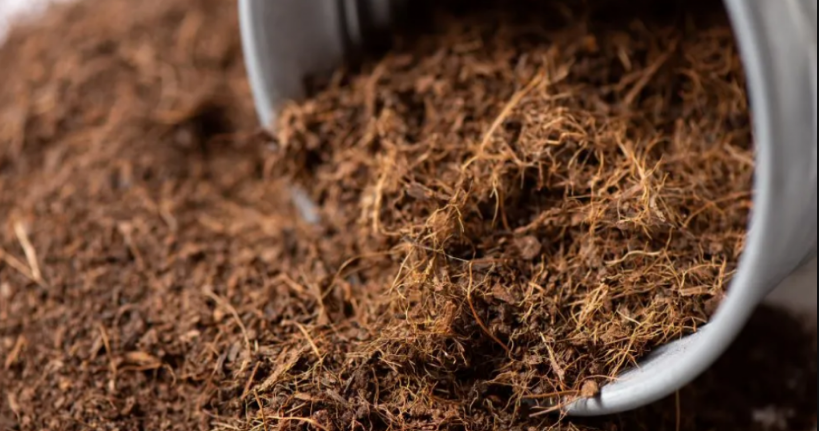
Making coco peat at home involves processing coconut coir, which is the fibrous material derived from coconut husks. While it may not be possible to produce the exact commercially available coco peat, you can create a similar coir dust or coir fiber material that can be used as a planting medium or soil amendment. Here’s a simple guide on how to make coco peat at home:
Materials Needed:
- Coconut husks (you can get these from fresh coconuts or purchase coconut husk chips)
- Large container or bucket
- Water
- Sharp knife or coconut husk shredder
- Sunlight (optional, for drying)
Steps:
1. Extract the Coconut Fiber:
Using a sharp knife, cut open the coconut to access the flesh inside. Carefully remove the coconut flesh, and then extract the coconut husk or fiber. The coconut husk is the fibrous layer found between the outer shell and the inner flesh.
2. Separate the Fiber from the Pith:
The coconut husk consists of two parts – the outer coir fiber and the inner pith (also known as coco peat or coir dust). To separate them, you can either manually pull the fibers away from the pith or use a coconut husk shredder to break them into smaller pieces.
3. Wash and Soak the Coir:
Place the coir pith (coco peat) in a large container or bucket and rinse it thoroughly with water to remove any impurities or excess salts. Then, fill the container with water and let the coir soak for several hours or overnight. Soaking helps to soften the coir and make it more manageable.
4. Drain the Coir:
After soaking, drain the excess water from the container. You can use a sieve or colander to separate the coir from the water.
5. Dry the Coir (Optional):
If you want to store the coir for later use, you can spread it out on a clean surface in a sunny area to dry. The drying process may take a few days, depending on the weather conditions.
6. Use the Coir:
Once the coir is dry, it can be used as a planting medium or soil amendment in your garden or potted plants. It provides excellent water retention and aeration properties, making it beneficial for plant growth.
How to make coco peat brick?
Making a coco peat brick is a simple process that involves compressing and dehydrating coconut coir into a compact form. Coco peat bricks are a convenient way to store and transport coco peat, and they expand when hydrated for use as a planting medium or soil amendment. Here’s a step-by-step guide on how to make a coco peat brick:
Materials Needed:
- Coconut coir (coconut husk fiber)
- Large container or bucket
- Water
- Coco peat brick mold (available at gardening stores)
- Heavy object or weight (to compress the brick)
- Drying area (sunny spot or well-ventilated space)
Steps:
1. Prepare the Coconut Coir:
Start by breaking down the coconut coir into smaller pieces. If you have coconut husk chips, you can shred them into finer pieces using a coconut husk shredder or by manually breaking them apart.
2. Hydrate the Coir:
Place the coconut coir in a large container or bucket and add water to the coir. The coir will absorb water and expand. Allow it to soak for several hours or until it becomes soft and pliable.
3. Fill the Coco Peat Brick Mold:
Take the coco peat brick mold and fill it with the hydrated coconut coir. Press down firmly to ensure the coir is evenly distributed and compacted inside the mold.
4. Compress the Coir:
Place a heavy object or weight on top of the coir-filled mold to compress it further. This compression helps in shaping the coir into a solid brick form.
5. Remove Excess Water:
After compressing, drain any excess water from the mold. The coir should be moist but not excessively wet.
6. Leave the Coir to Dry:
Remove the weight and allow the compressed coir in the mold to dry. You can place the mold in a sunny spot or a well-ventilated area to expedite the drying process. Depending on the humidity and temperature, it may take a few days to dry completely.
7.Unmold the Coco Peat Brick:
Once the compressed coir has dried and hardened, carefully remove the coco peat brick from the mold.
8. Store the Coco Peat Brick:
Your coco peat brick is now ready for use or storage. Keep it in a dry place until you are ready to use it for gardening purposes.
Applications of coco peat
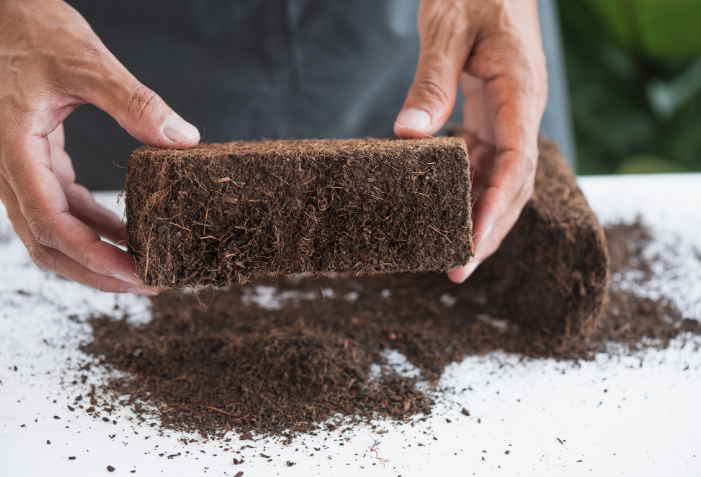
Coco peat, also known as coir or coir dust, has a wide range of applications across various industries due to its unique properties and versatility. Some of the main applications of coco peat are:
1. Gardening and Horticulture:
Coco peat is extensively used in gardening as a planting medium and soil amendment. It is used in potting mixes, raised beds, container gardening, hydroponics, and other soilless cultivation methods.
2. Agriculture:
In traditional agriculture, coco peat is used to improve soil structure, water retention, and nutrient availability. It can be mixed with garden soil to enhance fertility and drainage.
3. Hydroponics and Aquaponics:
Coco peat is an ideal substrate in hydroponic and aquaponic systems. It provides essential support for plant roots and helps maintain an optimal water-to-air ratio in these soilless cultivation methods.
4.Seed Starting and Plant Propagation:
Coco peat provides a nurturing environment for germinating seeds and rooting cuttings. Its fine texture promotes seedling emergence and early root development.
5. Soil Amendment and Improving Soil Quality:
Coco peat can be added to garden soil to improve its structure, aeration, and water-holding capacity. It helps in loosening heavy soils and enhancing their overall fertility.
6. Erosion Control:
Coco peat is used in erosion control applications to stabilize soil on slopes and prevent soil erosion.
7. Mulching:
Coco peat can be used as mulch to cover the soil surface around plants. Mulching with coco peat helps retain soil moisture, suppress weeds, and regulate soil temperature.
8. Animal Bedding:
Coco peat can be used as bedding material for livestock and pets, providing a soft and absorbent surface.
9. Vermicomposting:
Coco peat serves as a bedding material for vermicomposting, creating a suitable habitat for earthworms and supporting efficient composting.
10. Green Roofs:
Coco peat is utilized in green roof systems to provide a lightweight, moisture-retentive substrate for growing plants on rooftops.
11. Industrial Applications:
Coco peat is used in industrial applications such as erosion control mats, geotextiles, and as a component in growing media for bioremediation purposes.
12. Research and Educational Purposes:
In research and educational settings, coco peat is used for plant studies, experiments, and demonstrations due to its consistency and controllable properties.
What makes coco peat ideal for horticulture?
Coco peat is considered ideal for horticulture due to a combination of unique properties and benefits that cater to the specific needs of plants and horticultural practices. Here are the key factors that make coco peat an excellent choice for horticulture:
1. Water Retention:
Coco peat has exceptional water retention capabilities, holding up to 10 times its weight in water. This property ensures a steady supply of moisture to plant roots, reducing the frequency of watering and making it suitable for a wide range of plants with varying water requirements.
2. Aeration:
The fibrous structure of coco peat allows for excellent air circulation within the root zone. This enhanced aeration promotes healthy root growth and prevents waterlogging, ensuring that plant roots receive sufficient oxygen for optimal development.
3.Nutrient Absorption:
While coco peat itself is low in nutrients, it acts as an efficient medium for nutrient absorption and retention. It can hold and release nutrients to plant roots, providing a conducive environment for nutrient uptake and minimizing nutrient leaching.
4. pH Neutral:
Coco peat has a neutral pH level, typically ranging from 5.5 to 6.5, which makes it compatible with a wide range of plants. Its pH neutrality creates a stable environment for plant roots, reducing the risk of pH-related nutrient deficiencies or toxicities.
5. Disease Resistance:
Coco peat exhibits inherent resistance to harmful pathogens and pests, reducing the risk of soil-borne diseases and pests affecting plant growth. This property contributes to healthier and more robust plants, especially in greenhouse and nursery settings.
6. Sustainable and Renewable Resource:
Coco peat is derived from coconut husks, which are a byproduct of coconut cultivation. It is a renewable and eco-friendly resource, making it a sustainable choice for horticultural practices.
7. Weed Suppression:
Coco peat has natural weed-suppressing properties, inhibiting weed germination and growth. This characteristic helps maintain a cleaner garden environment and reduces the competition for nutrients and resources.
8. Lightweight and Easy to Handle:
Coco peat is lightweight, making it easy to handle and maneuver. This feature is particularly advantageous for container gardening, rooftop gardens, and other applications where weight is a concern.
9. Versatility:
Coco peat is a versatile planting medium that can be used in various horticultural applications, including potting mixes, seed starting, hydroponics, raised beds, and more.
10. Reusability:
Coco peat can be reused for multiple growing seasons with proper care and maintenance. After a harvest, it can be revitalized by adding fresh nutrients and blended with new materials for subsequent plantings.
What can go wrong with coco peat?
While coco peat offers numerous benefits and is generally a reliable planting medium, several potential issues can arise when using it. Understanding these challenges can help gardeners and growers address them effectively.
Here are some common problems or issues that can occur with coco peat:
1. Overwatering:
Coco peat has excellent water retention properties, but excessive watering can lead to waterlogged roots and root rot. It’s essential to monitor the moisture levels and adjust watering accordingly to prevent overwatering.
2. Nutrient Imbalance:
Coco peat itself is low in nutrients, so it’s crucial to supplement it with fertilizers or nutrient solutions. Failure to provide adequate nutrients can lead to nutrient deficiencies in plants.
3. Salinity Issues:
Some coco peat may contain high levels of salts. If not adequately washed or buffered, these salts can negatively affect plant growth. It’s essential to use high-quality, well-prepared coco peat to avoid salinity problems.
4. pH Fluctuations
While coco peat has a neutral pH, it can slightly fluctuate depending on the water and nutrient inputs. Regular monitoring of pH levels and appropriate adjustments are necessary to maintain the optimal pH range for plants.
Compactness: Over time, coco peat may become compacted, reducing its aeration and drainage properties. Regularly fluffing or loosening the coco peat can help maintain its ideal structure.
5. Presence of Debris:
Coco peat obtained from low-quality sources may contain impurities, such as debris or fibrous materials. It’s essential to choose clean and well-processed coco peat to avoid these issues.
6. Unsuitable for Some Plants:
While coco peat is suitable for many plant species, some plants may have specific needs that are not met by coco peat alone. Certain plants, especially those adapted to specific soil types or pH levels, may not thrive in coco peat.
7. Environmental Concerns:
While coco peat is a sustainable resource, its production and transportation may have associated environmental impacts, such as energy consumption and carbon emissions. Choosing responsibly sourced coco peat can help mitigate these concerns.
8. Inconsistent Quality:
The quality of commercially available coco peat can vary. It’s crucial to purchase from reputable suppliers to ensure consistent and reliable performance.
9. Storage and Pest Issues:
If coco peat is stored in a humid or unclean environment, it can attract pests or develop mold. Proper storage in a dry and well-ventilated area is essential to prevent these problems.
FAQ
1.Why is peat used for plants?
Apologies for the duplicated information provided in the earlier reply. Peat is not commonly used for plants. Instead, it is peat moss (sphagnum moss) that is used for horticultural purposes.
Peat moss has properties beneficial to plants, as mentioned earlier.
2. What is the lifespan of cocopeat?
The lifespan of coco peat (also known as coir peat or coir dust) depends on how it is used and the specific conditions it is subjected to. Generally, when used as a soil amendment or in potting mixes, coco peat can last for several years, especially if it is well-maintained and not subjected to extreme conditions.
3. What are the disadvantages of coco peat?
While coco peat has many advantages, it also has some disadvantages:
- High potassium content: Coco peat has a relatively high potassium content, which may not be suitable for all plant types, especially those that require a low-potassium environment.
- pH level: Coco peat tends to be more alkaline, and this pH may not be ideal for plants that prefer acidic conditions. However, this can be balanced by using appropriate soil amendments or additives.
- Compactness: Over time, if not adequately fluffed and maintained, coco peat can become compacted, reducing its aeration and water retention abilities.
- High salt content: Some coco peat products may contain excessive salts, which could negatively affect plant growth. Proper rinsing or using high-quality coco peat can mitigate this issue.
- Limited nutrient content: While coco peat has some natural nutrients, it is relatively low in essential plant nutrients compared to other growing media. Supplementing with fertilizers is often necessary.
4. What is the difference between peat and coco peat?
The primary difference between peat and coco peat lies in their origin and composition:
- Peat: Peat is a type of soil formed from the decomposition of organic matter (usually sphagnum moss) in waterlogged conditions over long periods. It is typically found in natural peatlands or bogs.
- Coco peat: Coco peat, on the other hand, is a byproduct of the coconut industry. The fibrous material that it originates from is discovered amid the coconut husk and the outer shell. The husks are processed to extract coir fibers used for various applications, and the residual dust-like material is called coco peat.
5. Is coco peat better than coco coir?
Coco peat and coco coir are often used interchangeably, but they are slightly different products.
- Coco peat: As discussed earlier, coco peat refers to the dusty, finer material that comes from the processing of coconut husks. It has good water retention and aeration properties, making it suitable for use in potting mixes.
- Coco coir: Coco coir, on the other hand, refers to the coarser fibers obtained from coconut husks. It is commonly used for erosion control, as a component in growing media, and as a soil amendment. It has better drainage than coco peat and provides good support to plant roots.
Conclusion:
Coco peat soil is an invaluable resource for sustainable gardening practices, embodying the principles of eco-friendliness and efficiency.
As we strive towards greener and more responsible horticulture, embracing coco peat soil as our preferred planting medium can lead us to a brighter and more sustainable future for our gardens and the environment.
So, why not take the leap and make coco peat soil an integral part of our gardening journey? Together, let’s nurture nature and reap the rewards of this remarkable gift from coconut palms.
